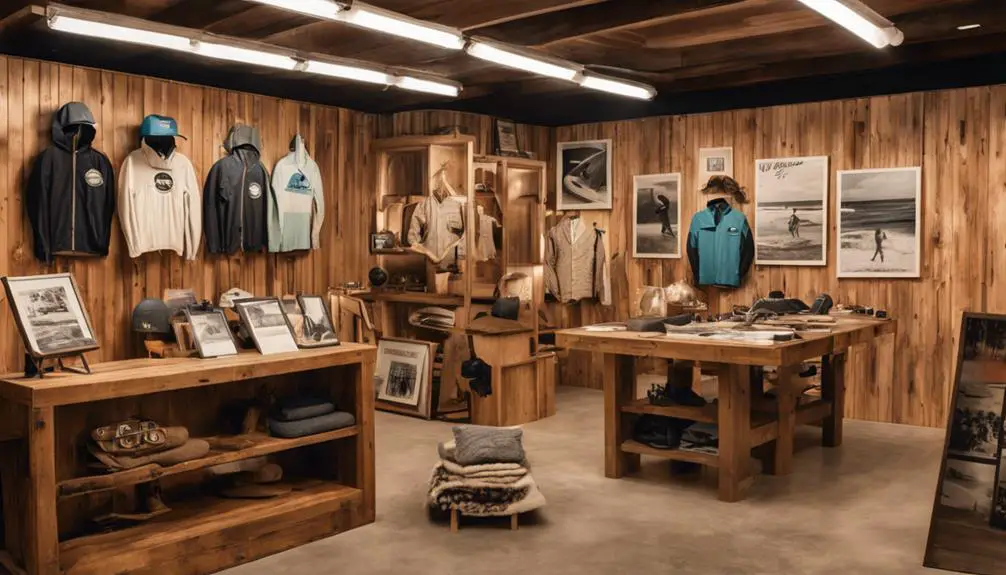You might be surprised to learn that Quiksilver, a cornerstone of surf culture, was founded in 1969 in Torquay, Australia, by Alan Green and John Law. Initially, they focused on wetsuits and sheepskin boots, but it was their introduction of the first technical boardshorts in 1973 that truly set them apart. With just a $2,500 loan and their first sale to a local surf shop, they began carving a niche in a growing market. But what drove their early success, and how did they navigate the challenges that came next?
The Origins of Quiksilver

In 1969, Quiksilver took its first steps in a garage in Torquay, Australia, where Alan Green began crafting wetsuits and sheepskin boots for surfers. This humble beginning ignited a passion for innovation that would soon revolutionize the surfing industry.
With a keen understanding of what surfers needed, Alan focused on enhancing their experience through better gear, much like how Billabong started by catering to surfers' needs. He secured a $2,500 loan from his father, setting the stage for a brand that would stand out among its competitors.
By 1973, Quiksilver officially emerged as a brand, concentrating on developing innovative boardshorts. These weren't just any shorts; they were designed specifically for improved surfing performance.
The first technical boardshort, boasting unique snaps and Velcro, was a game-changer. This functional design not only provided surfers with a more comfortable experience but also set Quiksilver apart in a crowded market. You can imagine the excitement that came from wearing gear specifically engineered for the waves!
Quiksilver's first customer, Klemm-Bell surf shop in Melbourne, quickly became a key player in the brand's early success. As word spread, sales skyrocketed, and distribution expanded along the coast, fueling the brand's growth.
Alan Green's vision and determination laid the groundwork for what would become a global icon in surfing culture. With every stitch and seam, Quiksilver has remained committed to serving surfers, making waves in the industry from its very inception.
Early Growth and Development
Quiksilver's early growth was nothing short of remarkable. Founded in 1969 by Alan Green and John Law in Torquay, Victoria, Australia, the brand initially focused on producing high-quality wetsuits. As the surfing culture began to thrive, Quiksilver quickly adapted, launching its first technical boardshort in 1973, which featured a unique yoke waist design that enhanced comfort, setting the stage for innovation in surfwear.
As you trace Quiksilver's development, you'll notice pivotal moments that fueled its ascent:
- Partnership with Jeff Hakman: In 1975, this partnership secured U.S. distribution rights, opening the doors to the American market.
- Going Public: Quiksilver took a significant step by going public on the New York Stock Exchange in 1986, with sales approaching $20 million.
- Rapid Revenue Growth: By 1995, revenue skyrocketed to $174 million.
- International Reach: Quiksilver broadened product offerings and established a global distribution network.
- Breaking the Billion-Dollar Mark: By 2004, the brand exceeded $1 billion in revenue, showcasing its widespread popularity.
Through these strategic moves, Quiksilver solidified its position as a leader in the surfwear industry, enchanting surfers and outdoor enthusiasts alike.
This early phase laid a strong foundation for the brand's future expansions, allowing it to flourish and innovate continuously.
Expansion and Major Milestones

The journey of Quiksilver from a local wetsuit manufacturer to a global surfwear powerhouse is marked by considerable expansion and key milestones. Founded in 1969 by Alan Green and John Law in Torquay, Australia, Quiksilver initially focused on crafting wetsuits and boardshorts for surfers.
The brand truly established itself in 1973 with the launch of its first boardshorts, which quickly became a favorite among Australian surfers. This success paved the way for Quiksilver Inc's first major expansion into the U.S. market in 1976 through a licensing agreement with Jeff Hakman, setting the stage for international distribution.
By 1986, the company had gone public on the New York Stock Exchange, achieving sales approaching $20 million. The proceeds from the IPO allowed for further expansion, enhancing production capabilities to meet the growing demand for its products.
One of the most remarkable milestones occurred in 2004 when Quiksilver surpassed $1 billion in revenue following its acquisition of DC Shoes, a strategic move that considerably broadened its brand portfolio. The momentum continued, and by 2008, Quiksilver reached a staggering $2.2 billion in net revenues.
These milestones illustrate not just the financial success of Quiksilver but also its commitment to the surf lifestyle and culture, solidifying its position as a leader in the global surfwear industry. As you explore Quiksilver's journey, you'll see how each step contributed to its iconic status today.
Challenges and Restructuring
Challenges emerged for Quiksilver as it faced operational inefficiencies and the repercussions of over-diversification, leading to significant turmoil within the company. In September 2015, Quiksilver filed for Chapter 11 bankruptcy, a decisive moment that highlighted the urgent need for change.
The restructuring process that followed aimed to reduce debt and improve operations, allowing the company to rise from the ashes by early 2016. Similar to brands like Stone Island, which have navigated their own challenges while staying true to their cultural roots, Quiksilver sought to re-establish its identity and connect with its core audience through effective branding and product innovation a brand's cultural relevance.
During this transformative phase, several key changes took place:
- Leadership overhaul, including the retirement of Executive Chairman Bob McKnight
- Appointment of Pierre Agnes as President to steer the company
- Streamlined operations focused on core brands
- Realigned manufacturing processes to enhance brand identity
- Rebranding as Boardriders, Inc. in March 2017
These efforts were pivotal as Quiksilver sought to reclaim its footing in the action sports industry. By emphasizing its core strengths and refining its market direction, the company aimed to re-establish itself as a leader in the competitive landscape.
Through this restructuring, Quiksilver not only tackled its immediate challenges but also set a foundation for future growth. The journey wasn't easy, but with a renewed focus and a strategic vision, Quiksilver emerged with the resilience needed to thrive.
It's inspiring to see how a brand can adapt and evolve, turning challenges into opportunities, and continuing to capture the spirit of adventure that defines its essence.
Quiksilver's Legacy and Future

Since its founding in 1969, Quiksilver has carved out a significant legacy in the surf industry, shaping surf culture and youth fashion for generations. The brand's evolution over the decades, particularly through its logo changes and product lines, reflects the dynamic nature of surf culture and consumer preferences. You can feel the brand's influence everywhere, from the beaches to the streets, as it continues to resonate deeply with surf enthusiasts and fashion-forward youth alike.
One standout achievement is the launch of the ROXY line in 1991, which has become the leading action sport fashion apparel company for young women, contributing around 30% to Quiksilver's sales. This expansion not only diversified the brand but also showcased its commitment to inclusivity.
After emerging from Chapter 11 bankruptcy in 2016, Quiksilver rebranded itself as Boardriders, Inc., allowing the company to focus on its core markets and strengthen its brand identity. Quiksilver remains dedicated to sponsoring major surfing events and athletes, reinforcing its role as a essential player in the surfing community. This commitment helps promote surfing as a lifestyle and fosters growth within the boardsport community.
Looking ahead, Quiksilver's future is bright, with plans for growth and innovation on the horizon. The brand is actively pursuing sustainability initiatives and expanding product lines to engage younger demographics, ensuring it stays relevant in an ever-changing market.
As you embrace the Quiksilver lifestyle, know that you're part of a legacy that's not just about surf gear, but about a passionate community dedicated to adventure, expression, and a love for the ocean. This legacy is also marked by its historical logo evolution, further illustrating its impact on surf culture.





I and my pals came checking the excellent tactics from your web page and immediately developed a horrible suspicion I had not expressed respect to you for those secrets. All of the women were definitely as a result excited to study all of them and have sincerely been having fun with those things. Appreciate your genuinely so helpful and also for selecting variety of useful information millions of individuals are really desperate to be aware of. My personal sincere regret for not saying thanks to sooner.